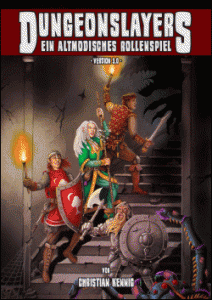 Yesterday, a few friends came over to my place to play some games. One of the things I had prepared was Dungeonslayers, a free, rules-light, old-school game. The 18-page rulebook contains the rules for playing the game, a couple of monsters and an introductory adventure called “Herr der Ratten” (Lord of the Rats).
Yesterday, a few friends came over to my place to play some games. One of the things I had prepared was Dungeonslayers, a free, rules-light, old-school game. The 18-page rulebook contains the rules for playing the game, a couple of monsters and an introductory adventure called “Herr der Ratten” (Lord of the Rats).
The character creation took ten minutes tops and my three players were ready to enter their first dungeon. The party consisted of a human fighter, an elven magic user (healer) and a dwarven scout. As all good old-school adventures, it started in the local inn where the inn keeper asked them to clear out a rat infestation in his wine cellar. So our three hero-wannebes entered the cellar, with sword and shield in hand. As soon as they reached the cellar they were attacked by a couple of rats.
The combat system in Dungeonslayers is pretty easy. You roll a d20. If your roll is equal or below your combat ability you have hit the opponent and your roll result is the damage you’ve dealt. So no extra damage roll (like in D&D etc.) is needed. Then the target may make a defense roll. The result of the defense roll (if successful) is substracted from the damage. It’s as easy as that. When all the enemies are killed, the GM hands out a couple of experience points.
After a couple of rooms, a lot of laughs and several killed rats my players reached an underground temple of an old rat cult. Although the temple was abandoned the evil influence of the rat gods’ altar could still be felt. In the end, they destroyed the altar, fought an animated statue of the rat god and returned to the surface with hands full of loot.
Dungeonslayers is a fun game that takes only minutes to get into. Although we are all veteran roleplayers we enjoyed the light-hearted nature of the game. We decided to continue playing DS next week. I am pretty sure that I can come up with a fun adventure on my own during the coming days or I will just adapt a D&D adventure to Dungeonslayers.
If you can read German, you really should check out Dungeonslayers ASAP. For everyone else, Christian Kennig (the creator of DS) and a few fans (including me) are going to translate the rules to english, so that more people can experience this fun game!

Well I'm all for a light game every once in while. Sadly, I'm going to have to wait. My German is only slightly better than my ability to speak Elvish.
<abbr><abbr>Bonemasters last blog post..My Failed Open Call Attempt</abbr></abbr>
Hehe. But things are looking good that we will have an english version of the Dungeonslayers rules soon enough. As of today I have finished the translation of the first 6 pages and when I can keep up that pace we will have a first draft in just a couple of days. So stay tuned.
I'm actually surprised that I can read enough of this to understand it without having to run to my Duden-Oxford dictionary. 🙂
And what do you think about Dungeonslayers?
I haven't had a chance to go through much of it, but it looks solid. I have finals in 3 weeks so I really can't dive into it all that much. 🙂
I found one confusing aspect to the game. There seems to be two separate sets of formulae for Zaubern and Zeilzauber. So, do they subtract PA or add ZB?
Zielzauber is for targeted spells like fireball, arrow of light and the like. Zauber is for other spells like healing which are mostly touch based.
Zielzauber is GEI+GE+ZB-PA
and
Zaubern is GEI+AU+ZB-PA
So armour (represented by PA) reduces your abiilty to cast spells and the Zauberbonus (casting bonus) improves your chance to cast spells.
I hope that cleared things up. By the way, I finished translation of the rules yesterday, so the english version of the rules is not that far away.
I thought I would bring it up because the formulae are not listed as such. They are given separately as GEI+GE+PA and GEI+GE+ZB on pages 4 and 5 respectively. The same holds true for Zaubern.